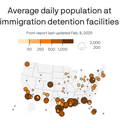Texas, Mississippi have the most detained immigrants
Facilities in Mississippi and Texas are holding the most detainees among the tens of thousands who've been rounded up across the nation during the ongoing crackdown on illegal immigration, according to newly released federal data.
The big picture: The data shed light on the housing arrangements federal officials have made for detainees at a time when the U.S. government's immigration centers are at near capacity — and the Trump White House is pushing for dramatically more arrests.
By the numbers: The Adams County Detention Center in Natchez, Miss., is holding the largest number of detainees for U.S. Immigration and Customs Enforcement (ICE), averaging 2,154 a day, according to the data collected by the Transactional Records Access Clearinghouse (TRAC) and reviewed by Axios.
- The South Texas ICE Processing Center in Pearsall, Texas has the second-most ICE detainees (1,680 a day), followed by the Stewart Detention Center in Lumpkin, Ga. (1,531 per day).
- No state is holding more immigration detainees than Texas: Eight detention centers in the state were among the nation's top 20 facilities that each are holding at least 800 people for ICE, according to an Axios review of the data, which runs through Feb. 8.
Zoom out: Overall, ICE was holding 41,169 in detention at the various locations. Nearly 55% of those have no criminal record, and many more have committed only minor offenses such as traffic violations, TRAC found.
- Also in the immigration system are more than 188,000 individuals and families who were in the Alternatives to Detention (ATD) program as of Jan. 11.
- This group includes nonviolent detainees who usually are given wristbands or ankle monitors, or told to check in by telephone, so that authorities can monitor them until their immigration court dates.
The ICE detention statistics update, which TRAC said has missing and incorrect data, did not report or make any reference to the number of detainees at the U.S. naval facility at Guantánamo Bay, Cuba.
How it works: Immigrants can end up in ICE detention after being arrested by ICE or the U.S. Border Patrol.
- Immigrants also can end up in detention after being arrested on criminal charges and released into ICE custody.
- Detention facilities can be run by the U.S. Federal Bureau of Prisons, state or local governments, private contractors, the U.S. Marshals Service or facilities ICE has for families.
- Mississippi's Adams County Detention Center is run by CoreCivic, a private prison company.
Between the lines: Holding immigrants in detention is by far the largest cost of the deportation process.
- A backlog of 3.7 million cases in immigration courts, where immigrants are entitled to make their case to stay in the U.S., means detained immigrants can wait months, even years, for a hearing.
- Undocumented immigrants facing criminal charges can't be deported immediately, as President Trump has suggested. Instead, they typically have to go through the criminal justice system, serve sentences if found guilty, then face deportation.
- To hold more people from a raid surge would require a mass building project of "soft detention" centers, or temporary facilities, to house immigrants beyond the system's current capacity of about 42,000 people.





















